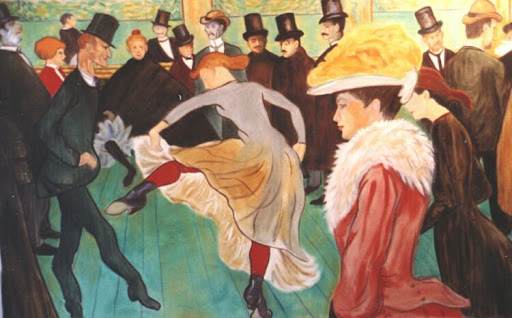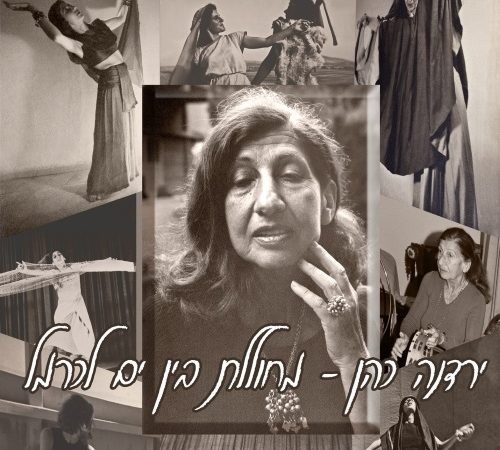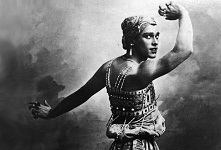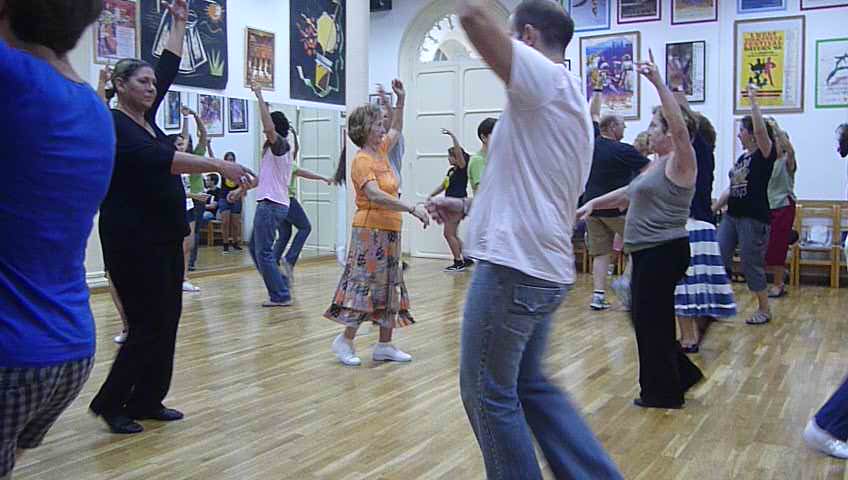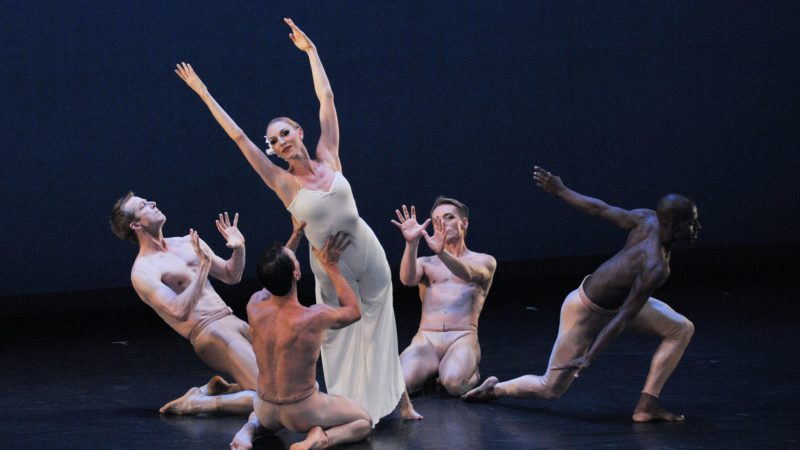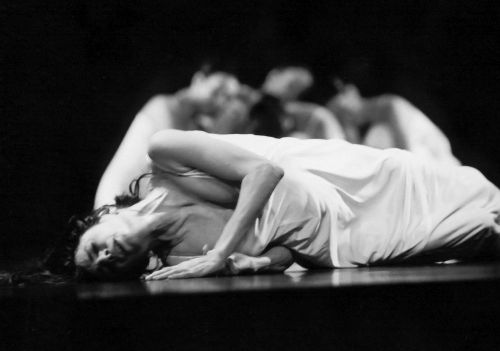White Noise: the Power of Protest
One of the most beautiful and exciting dances performed lately in Israel is White Noise, created by Noa Wertheim for the Vertigo Dance Company. White Noise was premiered in April 2008 in Suzanne Dellal Center in Tel-Aviv. The dance deals with life experiences in the 21st century, influenced and shaped by the uproar of consumerism, and the overflow of information. In Kalle Lasen's words:
For thousands of generations, the
ambient noise was rain and wind and
people talking. Now the soundtrack of the
world is vastly different. Today’s noise
is all-spectrum, undecodeable…The brain
learns to interpret white noise as a
background distraction…
The intriguing web of aesthetic work and ideas is what makes the dance distinct, contributing to the dialogue between human being and the universe.

White Noise, photo by Gadi Dagon
The concept of ‘white noise’ refers to the coincidental noise dispersed upon many frequencies, one that does not attract one's attention as common sounds do. ‘White noise’ obscures background noises of modern life together with natural and ordinary sounds, like twittering birds, or the stamping of feet. It all become a background-noise, until we almost hear nothing. ‘White noise’ presents a confrontation between cultural and natural representations, and focuses on the way the individual contends with the tension it creates between them.
Wertheim’s interest in issues that involve interactions between human beings and the environment is previously demonstrated in Birth of the Phoenix (2004), a dance project, performed outdoors, symbolizing the yearning for nature and spirituality against the everyday corporeal reality (Yudilovitz, 2004). In it each of the different chosen sites influences the quality of the dancers' moves, as well as the audience's reception. One such location were Birth of the Phoenix was performed is Karmiel’s plant nursery. The audience walked a considerable distance at midnight a long to see the dancers move and dance on the soft peat ground. Similarly, at Achziv beach the quality of the dance was affected by the warm and light sand and by the natural lighting of the sunset. This interaction with nature is seen in all the dance's locations, integrating the dance harmoniously with the surrounding environment and scenery.
A dance that is integrated with nature creates among its participants, performers, and spectators a physical reaction and a unique sense of excitement. The dynamic site-specific creativity adapts to the distinct quality of each location, thus creating an experience that embraces the experimental nature, the spontaneity, the exposure, and the intensity of the performance. Indeed, Birth of the Phoenix disappears after each performance without leaving a trace, and like the mythological bird that arises from the ashes, it is reborn anew at another time and location.
The company’s vision of social and environmental responsibility is deepened with the construction of "Vertigo in the Village", a cultural centre located in Kibbutz Netiv Halamed Heh in Israel’s Elah Valley. This new centre extends Vertigo’s interpretation of dance to include ecological and environmental concerns reaching far beyond the dance commitment that remains in its studio and dance school in Jerusalem. Vertigo in the Village is a cultural centre dedicated to exploring the relationship between movement and nature. The couple Wertheim and Adi Sha’al, who founded Vertigo Dance Company in 1992, see the model as a “center [that] is concerned with all matters artistic, ecological and spiritual in nature, and offers a variety of performances, workshops, festivals, and art-ecology meetings. Vertigo in the Village programs invites the public to experience an awareness of the environment through the body and through the art of dance”.
Wertheim and Sha’al’s commitment to a holistic approach, one that evolves art and life, is not a new idea in the dance world. Anna Halprin is a prominent and important artist that was involved with ecological dance that influenced significantly the avant-guard in the 1960s in the U.S.A., and has ramifications on dance today. Halprin and her husband, the architect Lawrence Halprin, built a community that was involved in ecological dance in the West Coast early of the 1960s. Lawrence designed and built a haven in a small town on the Pacific Ocean that supplied the needs of its participants and integrated harmoniously with the scenery (Worth & Poynor, 2004). The three principles that guided Halprin and those who worked with her were: the human body as a microcosm of the universe, nature processes gives aesthetical instructions, and that nature has healing abilities.
In Israel, one of the first artists to be involved in ecological projects was Ruth Ziv-Eyal. In 1978 she created Reminiscence Titles, which embraced everyday movement, lack of a linear narrative, use of objects with central purpose in the work, and a humanistic movement approach of the human body’s employment (Eshel, 2001). The piece involved a contemporary city, the media brainwash, violence, and accumulated piles of garbage. For that dance Ziv-Eyal used objects such as newspapers, brooms, dustbins, plastic hammers, and whistles. In another of her works, Cycle (1982), made with Neve Tzedek Theatre Group, she used primal human behavior and elements such as water, earth, and air. The work was performed in a pit dug in the ground, in which a group of men and women created a fascinating performance of primeval human existence made of water and earth. The performance ended when the performers rose from the pit and walked towards the audience, chanting (Manor, 1995).
Coming back to White Noise, its distinctive concern is cultural noise, the noise that exists in urban space. For the dance Wertheim chooses a conventional space – the theatre stage – in which to confront the audience with ecological issues. She exploits the performance’s accessibility, being presented in a conventional theatre, to enchant the spectators and attract them into the world she creates on stage. The artistic means in the dance is her individual movement language – the integration of everyday movement, organic and fluid movement based on contact improvisation, Eastern martial arts combined together with fast, physical, fragmented, and risky movement. However, the contribution of the dancers and co-creators – Ivica Bago, Alon Karniel, Maya Resheff, Shiran Sharabi, Oren Tishler, Eyal Visner, Rina Wertheim-Koren, Anat Yaffe, Vova Zak and Carmi Zisapel – is of great significant to the work.

White Noise, photo by Gadi Dagon
The spatial dimensions of the moving body range between movements that are drawn close to the body and movements that burst out from the body. The personal space movements occur on a vertical axis; distancing and approaching the ground, rising, falling and rolling on the ground. The meditative solo sections inlayed in the dance are presented separately or woven in the fast, violent group’s movement.
The techno music and musical compositions (composed by Ran Bagano) is another layer added to the movement noise. The stage design and costumes (by Ofir Hazan) sharpen the portrayal of brand name addiction as opposed to individual clothing, and enables distinct expression of the body with no gender tagging.
The dance opens with faceless dancers dressed in uniform who enter a dark stage, they climb and sit on lit-up squares down-stage (lighting by Dani Fishof). Only after they sit with their backs to the audience, we notice that the square lights are located on the high chairs themselves. To the monotonous sound they raise their shirts to expose bar-codes tattooed on their bare backs. The violent association to the act of tattooing is shocking. At the same time it endorses the audience's attention to the authorities’ attempts to make the human bodies become homogeneous and anonymous in the guise of self-defense and security, and in order to control them easily. When a human/creature/figure crosses the stage on four in elastic and flowing movement, the blurred boundaries between man and animal, and between ‘cultural’ and ‘natural’ representations intensify.
Later, to the sound of the same monotonous techno track played endlesslessly and overshadowing any other sound; two dancers enter the stage while confronting each other. They push, shove, and throw each other around violently, and when the dancers join, all contribute to the ceaseless noisy movement on stage. The chairs are dragged up-stage and the stage fills with bodies thrown in the air, struck to the ground and roll without a break. The added darting lighting creates an illusion of fragmented movement and broken body parts. Wertheim uses contact-improvisation techniques in an unusual context: the considerable and attentive contact becomes violent, aggressive, and alienated. This section ends in the dark and empty stage in which only the blind and cold screens gaze at the spectators.
On the empty stage in the next solo section, the screens present images of primeval scenery of a sea set with black basalt rocks. To the sound of a distant ship horn, a dancer (Maya Reshelf) moves in sensual cat-like movements with her hair bundled and raised in the baroque style. Concentrated in her body’s energy and isolated from the surroundings, she advances, while the scenery photos presented up-stage serve as simulacrum representations, reconstructing absent objects. The lines of light that the screens create, they illuminate and hide body parts of the moving image. She moves in an animal-like movement on a diagonal line from up-stage right to back-stage left. Her arched back joins the moving forward pelvis, and later responds to the knee that leads the advancement. Than, in a flowing movement her tower-hair leads the body and pulls after the torso. Her leg stretches backward, softly rising upwards, lowering and stretching ahead of her body while her pelvis approaches the ground.
The existential significance of interaction with and reliance on individuals within a group, is the theme of the another section in which men dance in courting-like ritual. Five male dancers move in unison as a group with affinity, trying to seduce the sensual human/animal dancing figure who sat on a high chair. To the rhythmic sound and lighting the men travel long distances on four as if they were crabs, their back or chest face alternately the ceiling. The movement displays that try to impress the distant figure include jumps and supinely falls, rolls, and pounces through the air to a partner’s arms. They move their pelvises in round and sensual movements and position themselves in a tight row as if they were one body. They sprawl on the ground in an Odalisque posture, related to Oriental femininity that is shown as an erotic posture (a subject that the artists Matisse, Ingres, and Renoir often painted), their legs wide apart and folded and their pelvises and sexual organs exposed. In spite of their efforts, the look of the center figure remains crestfallen.
The slow movement of a pregnant dancer, Carmi Zisapel, interrupts the men’s dance. She moves her pelvis forward and backward in a wavy movement, while falling and rolling on the ground, her movements end with continuous vibration. Her round movements are cut off by sharp movements and freezes, and flow again, elongating and vibrating. The dancers join her to a backward run, surround her and disperse.
The scenery images represented on the screens scattered in the dark stage are not pastoral this time. They show a dry and cracked earth, a testimony for an ill use by humans, and of controlling nature instead of being part of it. With these images as background the dancers enter the dark stage, their arms rise and drop tiresomely, and their bodies drop heavily to the ground. The slow movement is set with sharp movements, with arms extended as if longing for someone or something unreachable.
The dance ends in a section in which all the dancers move in a repeatable pattern of scattering and gathering. The energetic and fast movement or the slow and meditative is performed to the sound of minimalistic and repetitive music. The dancers spread out in big movements and wide steps, and than draw back to become a group in slow and smaller movements, and so on. The quality of the scattering and gathering movement of the group echoes their personal movement. The thrown movements are replaced with withdrawn and smaller movements, every time slower and closer to the ground. In one of the times, when the group spreads out, a dancer collapses backwards and is gathered by another dancer who places him with great care on the ground. The other dancers join in similar falls, while the other dancers support and place them on the ground. The repeated pattern intensifies, movement is then reduced and the bodies remain close to the comforting ground. Then, they rise heavily and in a unison walk they leave the stage and disappear in the dark.
White Noise is an irritating and violent dance but at the same time transmits an honest desire to influence and convince. Wertheim presents a beautiful and fascinating piece, in which all compositional components – movement, music and design – contribute to the whole. But alongside the aesthetic beauty she demands from the audience honest, openness and inner attentiveness without evasion, in order to be able to open channels to challenge issues she presents. The manner in which Wertheim chose to present the subject is not through abandoning the conventional theater, as she did in Birth of the Phoenix (2004), but through combining and presenting art and life side by side on the stage. The protest is what gives White Noise its power and meaning.
Bibliography
This article was published in Hebrew in Dance Today 14, 2008.
Eshel, Ruth. “What is Movement Theatre?” Dance Today. Vol. 5, 2001, pp. 27-33 (Hebrew edition).
Yudilovitz, Merav. “’Birth of the Phoenix’: a unique experience”. Ynet. 14 July, 2004. http://www.ynet.co.il/articles/1,7340,L-2947278,00.html
Manor, Giora. “Ruth Ziv-Eyal Amazing Journey”. Dance in Israel. Vol. 4, 1994, pp. 10-12 (Hebrew edition).
Worth, Libby & Poynor, Helen. Anna Halprin. London & New York: Routledge, 2004.
